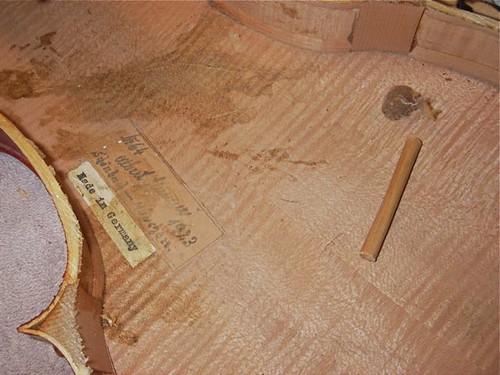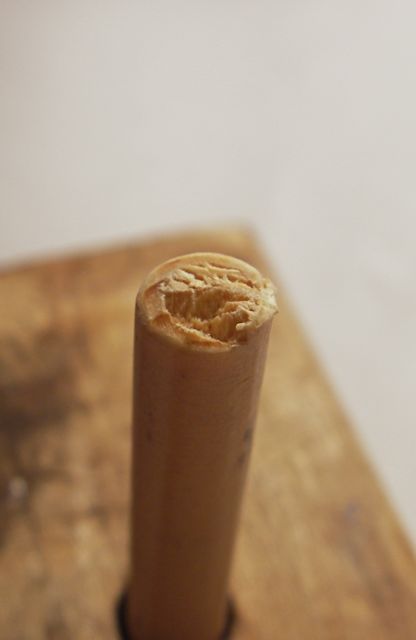Showing posts with label soundpost. Show all posts
Showing posts with label soundpost. Show all posts
Friday, October 25, 2013
Soundposts and craftsmanship
Cheap fiddles have been sold as long as fiddles have been sold. The customers are the poor or uneducated. It looks like a violin. I want to see if I like it before I spend much. The usual story we've all repeated when trying to save some money on something.
One came into the shop the other day. "Doesn't sound so good," was the complaint. Actually, "sounds really bad" was the complaint. The e-string was unbearable. Starting off with bad equipment is an easy way to answer the question "will I like it?", but that's part of the education angle.
Here's what the soundpost looked like.
This was how it was sold by a music store in the area -- a starter fiddle -- and at least implied that it was a product ready-to-go. It was not. Note the minor contact of the soundpost with the back. Not only will this prove less than optimal in tone, it is also dangerous for the instrument. Over time, this can create a crack in the back. Once a back-crack occurs on an instrument like this, it's all over. Out it goes with last week's garbage.
This factory-installed soundpost had badly cut bevels -- I actually doubt much thought was given to them at all -- and the post overall was too short.
We put a new one in.
We replaced the strings as well, the factory strings being only decorative. I probably shouldn't use the word 'decorative' that way.
It sounds much better now. Never going to be great, but at least it is essentially firing on all cylinders The owner might actually grow to like playing the fiddle.
Labels:
back,
repairs,
soundpost,
Student instruments,
violin repair
Tuesday, April 17, 2012
Fiddle hairball

Just another hairball photo. Many players are surprised to learn that a fiddle can have a hairball rolling around inside it, yet it is very common. This one, just above the loose soundpost, is actually fixed in place by rosin that has fallen in through the f-hole.
Some luthiers worry about these hairballs. I know folks who replace them after doing the repair work and others who collect them. I usually just take them out and throw them away, thinking they are something like 'dust bunnies' under the bed. So far, I haven't had any customers who expressed any interest in keeping them, either in their instruments or out.
Monday, January 23, 2012
Contempt for their product.
Another in the soundpost series -- an example of why it's not a good idea to simply give a quote for standing a soundpost. This one came out of a violin-shaped object. I had quoted them the price for a new soundpost, because I guessed that I wouldn't want to use what was bouncing around inside. There's something about the way this one was cut symbolizes the contempt with which many of these cheap Chinese vso's are made. Not even an effort at cutting a bevel. One should see smooth bevels that match the inner surface (top and bottom) of the the instrument. This one was simply crimped off, partially, then broken off the rest of the way.
Tuesday, January 10, 2012
Alternate methods of fitting a soundpost.
Consider, if you will, this soundpost removed from a customer's violin. The method of fitting: chew off the end of a stick, build it up with putty, then sand to the appropriate bevel. When inserting in the violin, add a dab of hide glue to the ends.
These are just some of the things they won't teach you in violin-repair courses.

Flashed view of the putty-end soundpost, to show a different contrast.
As interesting as this one was, I replaced it with a more traditional soundpost, one without putty or glue on the ends.

Subscribe to:
Posts (Atom)




